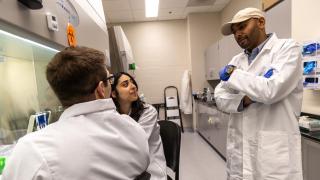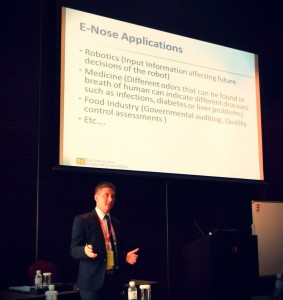

The bark of the family dog announced that his sister had returned home.
It didn’t matter where the dog was in the house or how quietly his sister entered the house: The greeting was always the same. And always, he barked only for the arrival of Kaja’s sister.
“I saw his amazing ability to smell and distinguish people and products,” Kaja said, “and I started to wonder how we could transform that ability for practical applications.”
Because of his background in robotics, Kaja thought of proposing an idea for a sensor that would mimic the olfaction function of the nose—an application that already interests those in the military and medical fields.
Kaja and classmate Ghanem Ahmed Raishouni began to work on plans for an electronic nose as part of their research paper for ECE 375: Computer Architecture, under the guidance of former UM-Dearborn professor Lubna Alazzawi. Their paper, “E-Nose, Developing a Standard Product,” focuses on the architecture of the sensor and the need for a standard version across fields.
“E-Nose encompasses human sensitivity to the objectivity of the instrumental response. It produces results similar to the human nose,” Kaja said.
He explains that the chemical properties recognized by the E-Nose sensor would transform to digital information, which then could be compared with information stored in the application’s database.
The idea is not new, Kaja notes. Over the years, various research institutions have worked to develop olfaction devices, but a standard version hasn’t emerged.
“Everyone keeps trying to reinvent the wheel at this point. It’s difficult when institutions don’t know the outcomes of others’ work,” Kaja said.
That’s one reason Kaja’s plans are open-sourced. He envisions others continuing to build off the initial work to develop new applications: Military personnel could send a robot into a non-secured area to detect the smell of certain chemicals or explosives; doctors could program the sensor to determine if he or she was diabetic—merely by a patient’s breath.
“Talking with other researchers about proposing this as a standard architecture and hearing about how it could be used has been an amazing experience,” he said.
Kaja recently presented his work at the 2013 International Symposium on Engineering and Natural Science (ISEANS) in Macau, China. The international trip was sponsored by the College of Engineering and Computer Science, the Department of Electrical and Computer Engineering, the Henry W. Patton Center for Engineering Education & Practice and the Office of Enrollment Management and Student Life.
“It was an amazing learning experience,” he said. “Having this kind of experience as an undergrad—learning how to research, how to raise funds and publish—and then talking with researchers from around the world strengthened my passion for research.”
The work is not done yet for Kaja. In February, he will present his research at the annual Tapia Conference, an event that brings together students, researchers and professionals to recognize the diversity in the computing fields.




